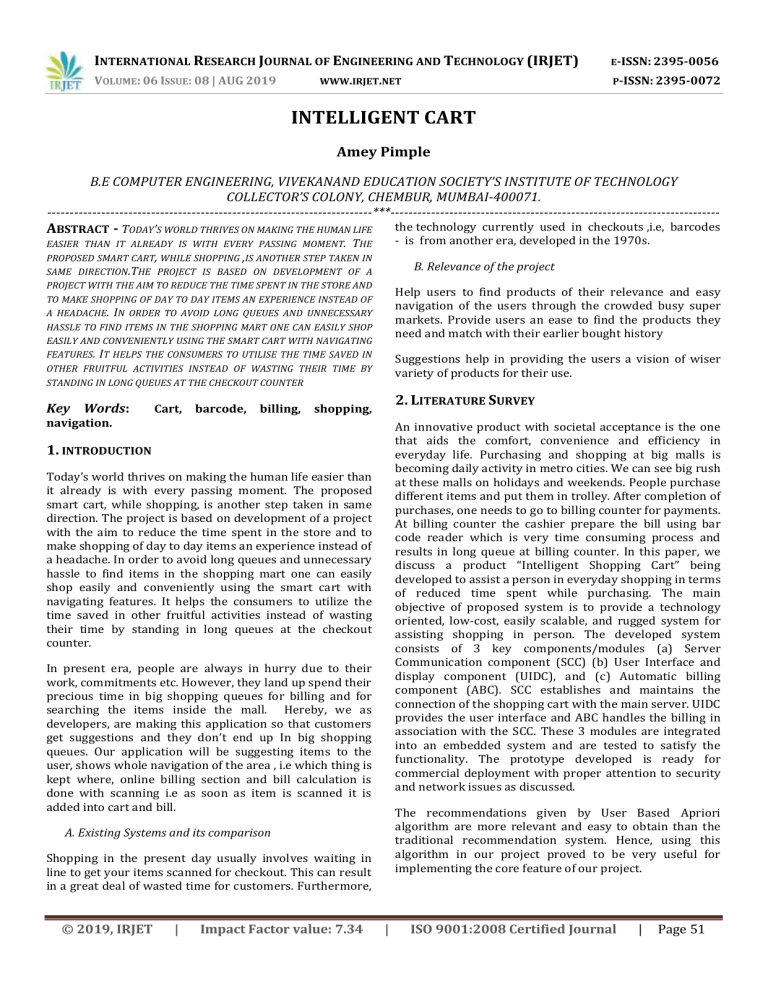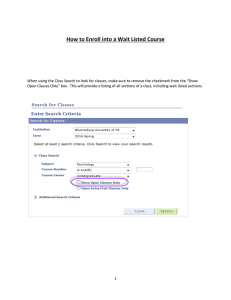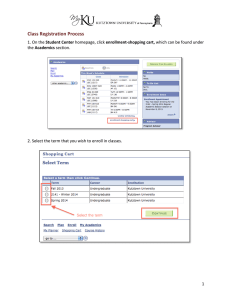IRJET-Intelligent Cart
advertisement

INTERNATIONAL RESEARCH JOURNAL OF ENGINEERING AND TECHNOLOGY (IRJET)
E-ISSN: 2395-0056
VOLUME: 06 ISSUE: 08 | AUG 2019
P-ISSN: 2395-0072
WWW.IRJET.NET
INTELLIGENT CART
Amey Pimple
B.E COMPUTER ENGINEERING, VIVEKANAND EDUCATION SOCIETY’S INSTITUTE OF TECHNOLOGY
COLLECTOR’S COLONY, CHEMBUR, MUMBAI-400071.
------------------------------------------------------------------------***-------------------------------------------------------------------------
ABSTRACT - TODAY’S WORLD THRIVES ON MAKING THE HUMAN LIFE
the technology currently used in checkouts ,i.e, barcodes
- is from another era, developed in the 1970s.
EASIER THAN IT ALREADY IS WITH EVERY PASSING MOMENT. THE
PROPOSED SMART CART, WHILE SHOPPING ,IS ANOTHER STEP TAKEN IN
SAME DIRECTION.THE PROJECT IS BASED ON DEVELOPMENT OF A
PROJECT WITH THE AIM TO REDUCE THE TIME SPENT IN THE STORE AND
TO MAKE SHOPPING OF DAY TO DAY ITEMS AN EXPERIENCE INSTEAD OF
A HEADACHE. IN ORDER TO AVOID LONG QUEUES AND UNNECESSARY
HASSLE TO FIND ITEMS IN THE SHOPPING MART ONE CAN EASILY SHOP
EASILY AND CONVENIENTLY USING THE SMART CART WITH NAVIGATING
FEATURES. IT HELPS THE CONSUMERS TO UTILISE THE TIME SAVED IN
OTHER FRUITFUL ACTIVITIES INSTEAD OF WASTING THEIR TIME BY
STANDING IN LONG QUEUES AT THE CHECKOUT COUNTER
Key Words:
Cart,
barcode,
billing,
B. Relevance of the project
Help users to find products of their relevance and easy
navigation of the users through the crowded busy super
markets. Provide users an ease to find the products they
need and match with their earlier bought history
Suggestions help in providing the users a vision of wiser
variety of products for their use.
2. LITERATURE SURVEY
shopping,
navigation.
An innovative product with societal acceptance is the one
that aids the comfort, convenience and efficiency in
everyday life. Purchasing and shopping at big malls is
becoming daily activity in metro cities. We can see big rush
at these malls on holidays and weekends. People purchase
different items and put them in trolley. After completion of
purchases, one needs to go to billing counter for payments.
At billing counter the cashier prepare the bill using bar
code reader which is very time consuming process and
results in long queue at billing counter. In this paper, we
discuss a product “Intelligent Shopping Cart” being
developed to assist a person in everyday shopping in terms
of reduced time spent while purchasing. The main
objective of proposed system is to provide a technology
oriented, low-cost, easily scalable, and rugged system for
assisting shopping in person. The developed system
consists of 3 key components/modules (a) Server
Communication component (SCC) (b) User Interface and
display component (UIDC), and (c) Automatic billing
component (ABC). SCC establishes and maintains the
connection of the shopping cart with the main server. UIDC
provides the user interface and ABC handles the billing in
association with the SCC. These 3 modules are integrated
into an embedded system and are tested to satisfy the
functionality. The prototype developed is ready for
commercial deployment with proper attention to security
and network issues as discussed.
1. INTRODUCTION
Today’s world thrives on making the human life easier than
it already is with every passing moment. The proposed
smart cart, while shopping, is another step taken in same
direction. The project is based on development of a project
with the aim to reduce the time spent in the store and to
make shopping of day to day items an experience instead of
a headache. In order to avoid long queues and unnecessary
hassle to find items in the shopping mart one can easily
shop easily and conveniently using the smart cart with
navigating features. It helps the consumers to utilize the
time saved in other fruitful activities instead of wasting
their time by standing in long queues at the checkout
counter.
In present era, people are always in hurry due to their
work, commitments etc. However, they land up spend their
precious time in big shopping queues for billing and for
searching the items inside the mall. Hereby, we as
developers, are making this application so that customers
get suggestions and they don’t end up In big shopping
queues. Our application will be suggesting items to the
user, shows whole navigation of the area , i.e which thing is
kept where, online billing section and bill calculation is
done with scanning i.e as soon as item is scanned it is
added into cart and bill.
The recommendations given by User Based Apriori
algorithm are more relevant and easy to obtain than the
traditional recommendation system. Hence, using this
algorithm in our project proved to be very useful for
implementing the core feature of our project.
A. Existing Systems and its comparison
Shopping in the present day usually involves waiting in
line to get your items scanned for checkout. This can result
in a great deal of wasted time for customers. Furthermore,
© 2019, IRJET
|
Impact Factor value: 7.34
|
ISO 9001:2008 Certified Journal
|
Page 51
INTERNATIONAL RESEARCH JOURNAL OF ENGINEERING AND TECHNOLOGY (IRJET)
E-ISSN: 2395-0056
VOLUME: 06 ISSUE: 04 | APR 2019
P-ISSN: 2395-0072
WWW.IRJET.NET
3. METHODOLOGY
B. Data Flow diagrams
The DFD Level 0 briefly shows the overall functionality of
the system. It only has one process – the Mobile
Application, which basically is the main component of the
whole system. The user gives the input and in output,
various products searched according to various filters or
recommended.
The project uses concepts of Cloud computing and Machine
Learning. The project aims at creating a smart shopping
cart which will detect different items placed in it. This will
be done with the help of a microcontroller say Barcode
scanners. Barcode scanners will detect the items kept in
the cart and their prices. The items are stored in the Cloud.
Predictive analysis would be performed thus to determine
the next move of the customer. Also the cart screen would
show the total pricing of the items placed in the cart.
Android Development: An app is developed for the users to
interact with the system by creating a interface with keeps
track of all the items bought and determining the current
position of the customer.
Indoor Map: An SDK of the indoor map consisting the data
points and navigation of the interface system to the actual
workspace of the supermarket is generated.
Fig. 2. DFD level 0
Machine Learning: For providing suggestions on various
items to be bought and that can be bought is given by the
Market Basket Analysis Algorithm, that is the Apriori
Algorithm.
A. Proposed design
The figure below shows the block diagram of our system.
We have a product where user can search for a item and
navigate through the supermarket. The user can search for
a product name directly or type the category of the product.
This input is then given to the cloud and the server gives
the results accordingly. In addition to this, the user can
navigate through the super-mart to find the product or
browse through the suggested options. The server then
gives the appropriate results. After the user is logged in, the
user can update his/her cart list depending upon the item
he/ she has bought showing the entire item list of the
products present in the cart.. Also, the user can have a look
at the products recommended for him/her based on the
previous search or history.
Fig. 3. DFD level 1
DFD Level 1 shows the functionality of system that user
is benefitted from
Fig. 1. Block diagram
Fig. 4. DFD level 2
© 2019, IRJET
|
Impact Factor value: 7.34
|
ISO 9001:2008 Certified Journal
|
Page 52
INTERNATIONAL RESEARCH JOURNAL OF ENGINEERING AND TECHNOLOGY (IRJET)
E-ISSN: 2395-0056
VOLUME: 06 ISSUE: 04 | APR 2019
P-ISSN: 2395-0072
WWW.IRJET.NET
Level 2 shows the functionality of core feature of the
system where suggestions to the user can be made. This is
also done on the basis of the data processed of the several
other customer behavior
E. Algorithms used
Apriori algorithm was used to implement the
recommendations feature. The code for the same was
written in Python. It is as follows:
C. Use-Case diagram
Step 0. Start with item-sets containing just a single item,
such as {apple} and {pear}.
Step 1. Determine the support for item-sets. Keep the
item-sets that meet your minimum support threshold, and
remove item-sets that do not.
Step 2. Using the item-sets you have kept from Step 1,
generate all the possible item-set configurations.
Step 3. Repeat Steps 1 & 2 until there are no more new
item-sets.
Example
A database has five transactions. Let the min support
= 50% and min confidence = 80%.
Fig. 5. use-case diagram
Features available to the users include that user
registration can be done through Google or Facebook. Once
the user enters the premises suggestions based on data
processing can be provided. Also the user can search for an
item within the Supermarket and the App can also be used
to navigate the customer through the supermarket. Further
for easy and quick processing of the bill at the checkout
system the products are scanned before hand to estimate
the bill calculation and provide an easy access to the
customer. The admin can access the navigation the system
and they are used to process and check the billing of the
system.
D. Overall flowchart of the sysytem
Fig. 7. Example of Apriori algorithm
Fig. 6. System flowchart
© 2019, IRJET
|
Impact Factor value: 7.34
|
ISO 9001:2008 Certified Journal
|
Page 53
INTERNATIONAL RESEARCH JOURNAL OF ENGINEERING AND TECHNOLOGY (IRJET)
E-ISSN: 2395-0056
VOLUME: 06 ISSUE: 04 | APR 2019
P-ISSN: 2395-0072
WWW.IRJET.NET
4. RESULT ANALYSIS
We convey our deep sense of gratitude to all teaching
and non-teaching staff for their constant encouragement,
support and selfless help throughout the project work. It is
great pleasure to acknowledge the help and suggestion,
which we received from the Department of Computer
Engineering.
A) Navigation Module - In this module, Products are
searched based on the product name or the category they
belong to. It will also navigate the user towards different
section.
We wish to express our profound thanks to all those
who helped us in gathering information about the project.
Our families too have provided moral support and
encouragement at several times.
B) Registration Module – Keeps track of all the users
that are registered to the system and all the items bought
by them and the items present in their cart.
C) Scanner Module – Customer can scan each product
and them to their cart .
7. REFERENCES
D) Bill Module – All the items present in the cart are
updated in the app and the cost is calculated in parallel.
[1]
E) Recommendation Module – The app recommends the
next item to be bought based on the previous data by
applying algorithms.
Shengnan Gai, Eui-Jung Jung, Byung-Ju Yi, "Mobile
shopping cart application using kinect", 1 0 th IEEE
URAI, pp. 289-291, 2013.
[2]
Hyojoo Cho, Woojin Chung, "Preliminary research on
robust leg-tracking indoor mobile robots by combining
the Kinect and the laser range finder information",
IEEE URAI, pp. 462-464, 2015.
[3]
Chuanjin Jiang, Wenguan Song, "The innovative profit
mode of third-party payment platform in China E Business and E -Government", ICEE, pp. 1-3, 2011.
[4]
Xiaofeng Yu, Yumei Zhao, Yang Wang, "The innovation
of e-commerce financial service product based on
cloud computing—taking Alibaba Finance as an
example", 10th International Conference on Service
Systems and Service Management, pp. 259-261, 2013.
[5]
T. Uno, M. Kiyomi, and H. Arimura, Lcm ver. 2: Efficient
mining algorithms for frequent/closed/maximal
itemsets. In B. Goethals, M. J. Zaki, and R. Bayardo,
editors, Proceedings of the IEEE ICDM Workshop on
Frequent Itemset Mining Implementations (FIMI'04),
volume 126 of CEUR Workshop Proceedings, Brighton,
UK, 2004.
[6]
B.R'acz. nonordfp:An FP-growth variation without
rebuilding the FPtree. In B. Goethals, M. J. Zaki, and R.
Bayardo, editors, Proceedings of the IEEE ICDM
Workshop
on
Frequent
Itemset
Mining
Implementations (FIMI'04), volume 126 of CEUR
Workshop Proceedings, Brighton, UK, 2004.L. SchmidtThieme. Algorithmic features of eclat. In B. Goethals, M.
J. Zaki, and R. Bayardo, editors, Proceedings of the
IEEEICDM Workshop on Frequent Itemset Mining
Implementations (FIMl'04), volume 126 of CEUR
Workshop Proceedings, Brighton, UK, 2004
[7]
Rakesb Agrawal, etc., Fast Algorithms for mining.
Association rules in Large Database, In: Jorge B. Bocca,
Matthias Jarke, Carlo Zaniolo etc. Proceedings of an
International Conference on Very Large Dat.
5. CONCLUSION
The main aim of the project was to make it easy for the
users to shop as per their requirements. They can search
items by their name, location in the mail, on the basis of
categories and similarities offered by the store. The users
can review their previously shopped list in the history tab.
They can search items on the basis of their current location.
They can look for recommendations given to them. They
can directly scan the item and put it into their shopping
carts, once the item is scanned it is stored in database and it
is shown to cart and billing section of the cart. Once the
user is done with the shopping one can directly pay the bill
via online payment. This was done by using Market based
analysis Apriori algorithm. We have designed a application
that provides all these features. Users can avail these
features and accordingly chose an appropriate product.
6. ACKNOWLEDGEMENT
Iam thankful to our college Vivekanand Education
Society’s Institute of Technology for considering my project
and extending help at all stages needed during my work of
collecting information regarding the project.
It gives me immense pleasure to express my deep and
sincere gratitude to Assistant Professor Lifna C.S. (Project
Guide) for her kind help and valuable advice during the
development of project synopsis and for her guidance and
suggestions.
Iam deeply indebted to Head of the Computer
Department Dr. (Mrs.) Nupur Giri for giving me this
valuable opportunity to do this project. I express our hearty
thanks to them for their assistance without which it would
have been difficult in finishing this project synopsis and
project review successfully.
© 2019, IRJET
|
Impact Factor value: 7.34
|
ISO 9001:2008 Certified Journal
|
Page 54
INTERNATIONAL RESEARCH JOURNAL OF ENGINEERING AND TECHNOLOGY (IRJET)
E-ISSN: 2395-0056
VOLUME: 06 ISSUE: 04 | APR 2019
P-ISSN: 2395-0072
WWW.IRJET.NET
[8]
Wu-Jeng Li, Shu-Chu Tung, ShihMiao Huang, "Serverside Ladder Logic of a Web-based Supervisory Control
System", The First International Conference on
Engineering and Technology Innovation 2011 (ICETI
2011), November 11-15, 2011.
[9]
Shu-Chu Tung, Wu-Jeng Li, Shih-Miao Huang, "A Webbased Android Supervisory Control System", Applied
Mechanics and Materials, vol. 284-287, pp. 3211-3215,
January 2013.
© 2019, IRJET
|
Impact Factor value: 7.34
[10]
|
The world's first decoder supporting Windows Live
Barcode spec. for your PC, from QuickMark, the all
time favorite decoder for mobile phone users",
Retrieved
from:
http://www.quickmark.com.tw/English/news.
html#20061113.
ISO 9001:2008 Certified Journal
|
Page 55

